#like the current state of architecture is so sad look what they did to mcdonald’s why is it emo :( and what’s with the obsession with grey
Explore tagged Tumblr posts
Text
Poplar Forest & Bedford
When we first arrived at Poplar Forest that lies on the outskirts of Lynchburg in Bedford County, we were blown away by the beautiful landscape that surrounded Thomas Jefferson’s retreat. Our team had heard such good things about the historic site from those who work there, our professors, and fellow students, we knew it was a must see spot. When we walked into the visitors center, we were greeted by the most kind staff member that we have encountered at any historic site. He was helpful, sweet, and even asked us about our research. We felt very welcome as soon as we walked through the door. To begin the tour, we started with a fifteen minute video introduction to Poplar Forest. Before the tour began, we realized our tour guide seemed to have little enthusiasm when one man asked her if she was our tour guide and she responded with a flat “yes.” After that odd encounter, we watched the wonderfully done film on Jefferson’s retreat home. The short video captured the stories of Jefferson, the enslaved people who worked there, and the importance of the architecture of the site. We were all looking forward to the tour of the historic home and the rest of our day at Poplar Forest after this.
We began the tour outside of the octagonal mansion with our tour guide explaining the symmetric architecture that Jefferson wanted to experiment with. By combining all of the techniques he had seen in Europe, he created this small, yet grand mansion as his getaway. But, he is not the one who put the physical labor into creating this architectural masterpiece. The enslaved people of Poplar Forest are the real champions of constructing the illustrious home. Our tour guide made that clear when she described much of the back-breaking work the enslaved people, like John Hemings, put into the building. She pointed out the only asymmetric detail, the wing of the home, where the enslaved people spent most of their days cooking, cleaning, and keeping the home the way Jefferson wanted. Unlike other Jefferson designs, there was no other wing to complete the symmetry. As Travis McDonald would explain to us later, “the second wing is the million dollar question.” Speculation from staff who have greatly studied the wing says it was just unnecessary to add another space to the home. We walked a little further to see the newly reconstructed carriage turnaround to what it would have looked like in Jefferson’s day. At Poplar Forest, the staff has taken huge steps to ensure the complete correctness of their rebuilding of the home. Our tour guide made sure we knew this once we entered the home. We were all impressed by the moulding, exact replicas, and specificity of the measurements for the rooms. Not only is the representation of the home wonderfully done, but the interpretation was wonderful. Though our tour guide was a bit quiet and unenthused, she did not refrain from allowing Jefferson to be talked about as human and did not glorify him. She was able to express his architectural genius all the while letting us know he did not build one piece of it. He was wholly dependent on enslaved laborers to have his elitist lifestyle. It was encouraging to see a second site where Jefferson was able to be learned about earnestly and not in a God-like manner. Our tour guide also explained to us in the parlor room how he had a more familial side with his granddaughters who frequently accompanied him at Poplar Forest. In the last room, we got to see the room that mirrored Jefferson's bedroom. While his room was fully restored, this room was used as a progress room to show how the staff at Poplar Forest worked to recreate the Jeffersonian home after it had undergone fire and renovations from other residents. Also in this room was an original John Hemings door. This was a site to see as we all know that he was responsible for most of the ornate mouldings and doors in the original home. We all enjoyed the house tour and were incredibly impressed with all the work the staff at Poplar Forest has done in the short 40 years they have been a museum. In the grand scheme of things, 40 years and starting from scratch is not long for the project that they had ahead of them.
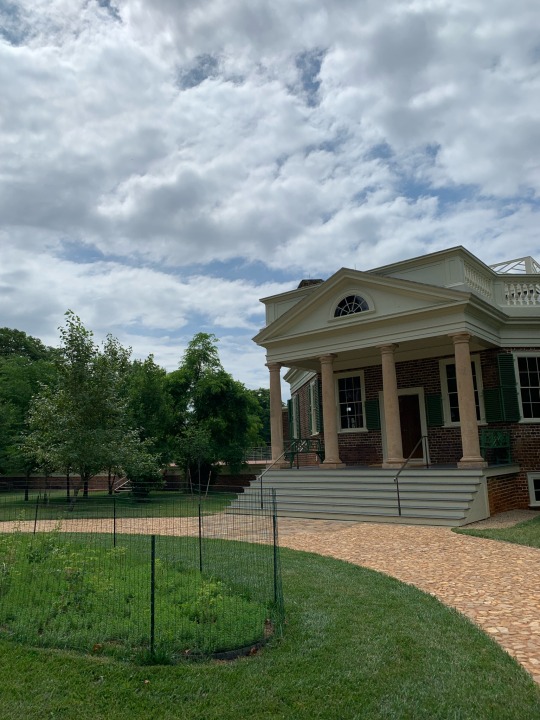
In the basement and the wing of the mansion is an exhibit dedicated to the enslaved workers of Poplar Forest. This was not a part of the house tour, but we made sure to see all that was displayed on our own. We saw the familiar name of John Hemings featured throughout. Without his tireless efforts, the home would not have been able to feature such unique architectural details. Though Thomas Jefferson was a master architect, he was never doing the hard work of actually building what he designed throughout his life. It was enlightening to see what archaeological finds have been discovered at the site. There was one display case that featured a series of items collected by rats in the attic of the home between 1846 and the 1960s, which was far beyond Thomas Jefferson’s ownership of the property. There were fragments of book pages, newspapers, clothes, and more. We walked over to see what was displayed in the wing between the east side of the home and the east mound, and we were amazed to find the kitchen with fireplaces, hearths, and a cook’s quarters. On display in one of the rooms was a letter from Hannah, an enslaved woman, written to Thomas Jefferson. In the letter, she expresses sadness about his inability to visit Poplar Forest that Fall and she also paraphrased the Bible - “we ought to serve and obey his commandments that you may set to win the prize and after glory run.” We believe this letter clearly shows a level of hopelessness and despair within Hannah, but it also depicts a unique dynamic of an enslaved person being allowed the ability to write. This must have been a unique circumstance. We are extremely pleased with the archaeological excavations done to bring the Wing of Offices back to their original form. Past the East mound are structures of the era beyond Thomas Jefferson’s ownership of the property and contained the living quarters of enslaved people during the antebellum era up through emancipation. There was a small exhibit in one of the spaces that allowed further learning about the enslaved. Down the hill and near a modern residential community is a reconstructed enslaved person quarters known as the North Hill site. It was built with logs and had a chimney lined with clay to avoid the spread of fires. A small garden likely existed since food rations were so limited. It was amazing to see the basic shape and size of what the enslaved lived within and is a stark contrast to the extravagance of the mansion. Reconstructing such structures allow sites like Poplar Forest to share the hard, yet necessary, truths of what enslavement looked like.
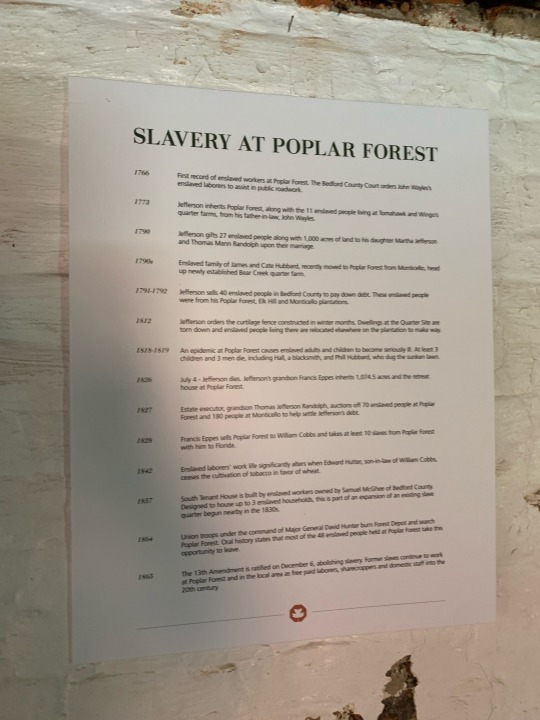

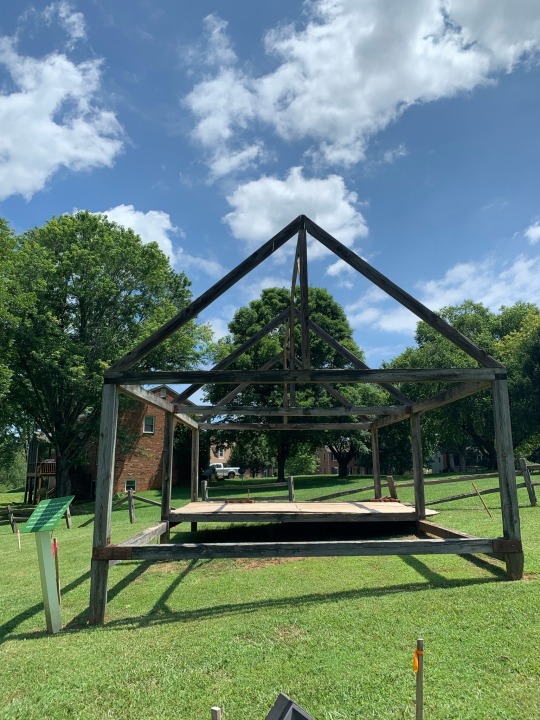

Our last stop after the gift shop at Poplar Forest was to Travis McDonald’s office. McDonald is the Director of Architectural Restoration at Poplar Forest. He has been with the foundation from the very beginning. His skills of being an architect, a restorationist, and a historian in his own right made him the perfect candidate for the position he has held for over 30 years. We were all so thankful that we got the opportunity to speak with him about Jefferson’s historic retreat. As we sat down in his office, the walls were lined with shelves encasing what seemed to be hundreds of books. On his desk and floor there were even more. The books that caught our attention were the Annette Gordon-Reed books, The Hemings of Monticello and Thomas Jefferson and Sally Hemings. His devotion to the ever evolving story of Jefferson was told to us before he even began talking. He told us right off the bat that Poplar forest “strives for historical accuracy over idealistic perceptions.” Since we have been to many historic sites across the state this summer, we have seen a few places that do the opposite. It is so impressive that the foundation has wanted to do this from the very beginning. They have cut no corners in perfection - literally. He explained to us that Jefferson was not the originator of his own ideas, but a master of self-education. He was able to learn and combine many pre-existing cutting edge architectural techniques. From masters of the art like Andrea Palladio, Jefferson was able to utilize his knowledge and European ideas to create his own style. McDonald continued to give us wisdom when he connected his specialty of architecture to history. “Architecture is a lot like history. It gets reinterpreted as new evidence is found and progress can be made.” Our last question for McDonald was about his feelings towards the current issues of Confederate monuments. His answer blew all of us away as it contained sincere emotion and toiled thought. “I had to separate myself from seeing them as art and architecture. As a professional architect and restorationist, that is how I saw and appreciated them for a long time. But now, I have been able to separate myself from that and see what they truly mean.” It was enlightening to hear a professional who has been in his field for decades to share his feelings with us. Travis McDonald was so welcoming and we are so thankful to have had the opportunity to gain insight from him.
We ventured into the small town of Bedford after visiting Poplar Forest. In our earliest research, we found an article on “The War Between the States Museum'' at the Bedford Museum and Genealogical Library. Just from the title, we knew we needed to go see whatever it was. Of course, “the war between the states” is a lost cause term to amplify that states rights was the reason for the Civil War instead of the obvious cause: slavery. We went in and it was a dark, dimly lit place. There were a few staff members and they were kind to us when we asked for admission in the museum. The gift shop was filled with outdated books, old postcards, and Confederate memorabilia, so we gained more insight onto what was ahead in the exhibit spaces. We took what the museum employee called the “slowest elevator in the county” up to the top floor where the exhibit on the “war between the states'' was displayed. We walk in and it is a large room with many glass cases. Again, very dim and not well lit, we strained our eyes to read the exhibits. The first exhibit you see in the space is on “Blacks Service.” All of our mouths dropped. It was an exhibit amplifying the myth of Black Confederates. Yes, Africa Americans served in the Confederacy, but not by their own will. They served as enslaved persons to those in the war. None of us could barely stand to be in the museum any longer after this, but we pushed through. Confederate flags were everywhere, the use of the word “Yankee”, and an exhibit on how Jefferson Davis’ release from prison was “a way to heal the deep divide between the U.S.” was on display. It was mind blowing to see this shrine to the Lost Cause only thirty minutes away from Randolph. At the end of the exhibit, we noticed a little sign on the wall that said the Sons of the Confederate Veterans still meet at least once a month in the room. We were all in disbelief from the complete bias and shrine-like nature of the museum. We traveled downstairs to see the other exhibits on local Native Americans, local African Americans, WWI, and WWII. The Native American exhibit looked like it was a project that the local middle school students put together. The information was not terrible, but the display was embarrassing. The information was presented at an education level for 5th graders, yet there was no signage dictating that it was a children’s exhibit. In the local African American exhibit, there were artifacts from the former all-Black high school, the African American sheriff who just retired, and Carol M. Swain, the African American conservative political science professor and Republican advocate. It was nice to see the information displayed about successful locals, but the message was clear. Overall, the museum experience was subpar. We all knew what we were walking into, but somehow it was worse than we could have imagined. We hope one day that the staff at the Bedford Museum and Genealogical Library will improve their interpretation.

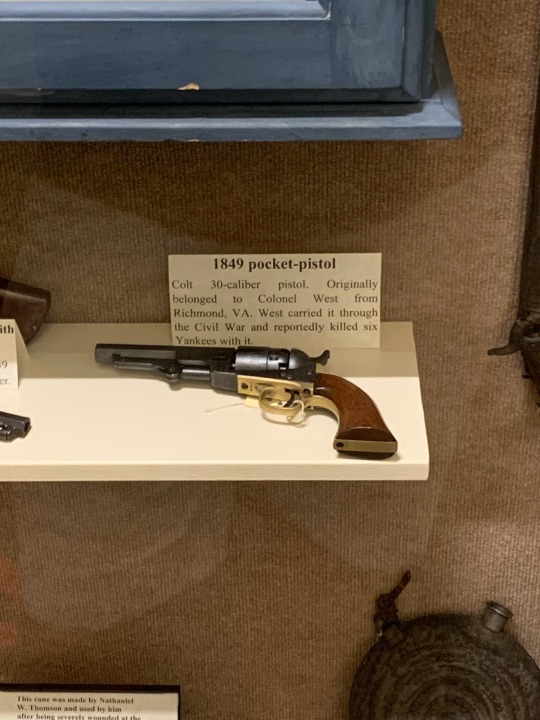
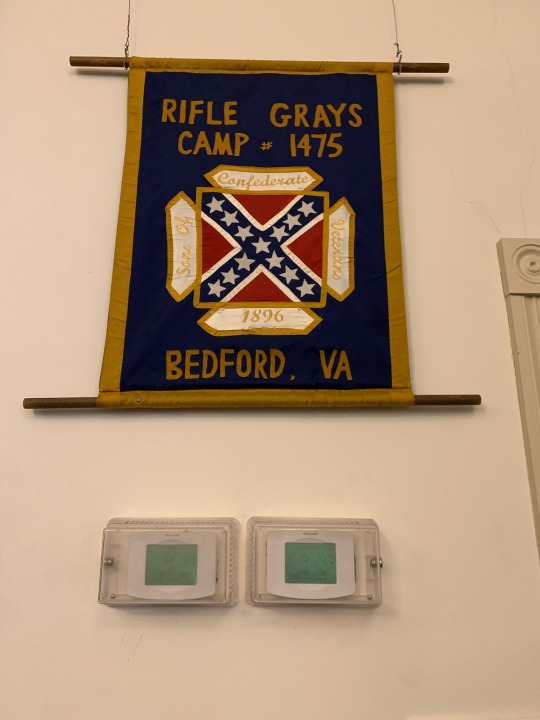
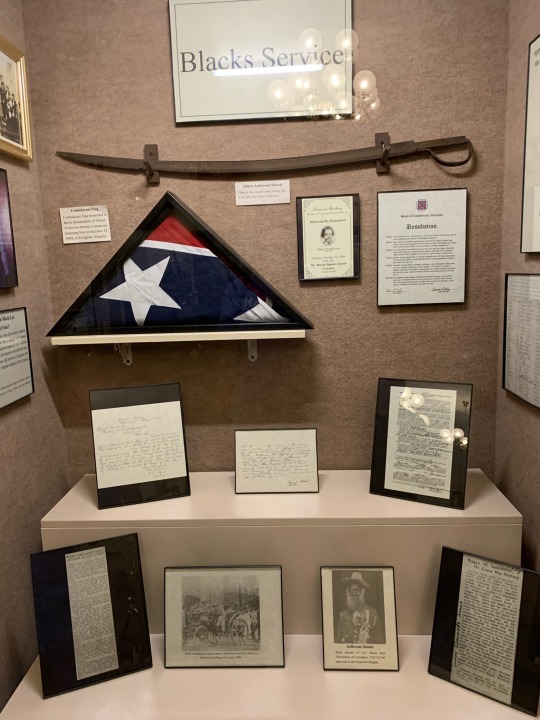
Before we left the town of Bedford, we took a close look at the Confederate monument that stands in front of the Bedford County Courthouse. The text at the base of the high obelisk below a carved battle flag says “Bedford honors her heroes; proudly rejoicing with the living; sincerely mourning the dead. Their history is its brightest pace...This stone is erected to keep fresh in memory the noble deeds of these devoted sons.” Obviously, this monument reeks of the lost cause and does not honor a piece of history that all can be proud of. Taking down such a problematic statue would not be “erasing history,” as Bedford supervisor candidates stated in 2017. The public should play a role in discussions of what to do with the obelisk, but it certainly does not belong in front of such an important government building. Once again, the United Daughters of the Confederacy supported the construction of a heinous monument at a time (1909) when African-Americans faced acts of discrimination and bigotry. If people were able to put themselves in the shoes of those most affected by the presence of such an awful monument, then we would finally be able to make lasting changes for the betterment of us all.
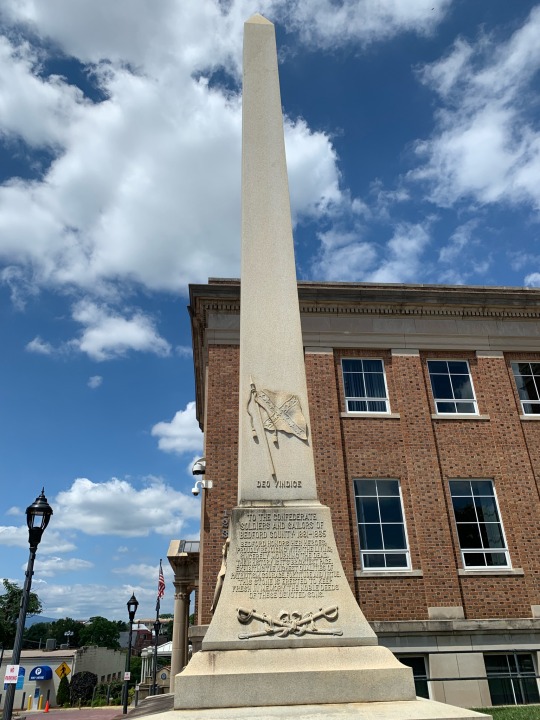
0 notes